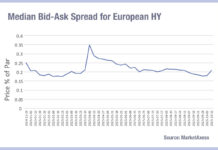Equity venues are dating apps – you have to be a member to use the central limit order book (CLOB), and it will match you up with a counterpart based on its rules.
In corporate bond markets, venues are bars – you can meet counterparts there, but you have to do most of the asking. To be fair, that is changing. Increasingly, corporate bond trading venues are finding ways to help their clientele to meet the right counterparty. In some cases, they are even offering automated matching.
Nevertheless, this slightly lurid analogy offers a helpful way of illustrating the problems of equating equity and fixed income trading workflows. There is not much point having a ‘digital interface’ to a bar. Equally, don’t try to phone a dating app. That in essence is why bond traders are struggling to use trading technologies, like execution management systems (EMSs), which are commonplace in equities.
Taking a more real-world view of the situation, the differences between a market using a CLOB and more introductory trading protocols are significant, especially in the discovery and aggregation of data. While an equity broker routes a buy-side order to a venue, a credit venue routes a buy-side order to broker-dealer. Prices are aggregated and anonymised in equity markets, in bond markets they are singular and personal.
That makes a credit trading venue a very different proposition to the equity venue. It needs to provide pre-trade pricing information and order routing. It needs to provide the equivalent of ‘order types’ seen in equity venues, but on the understanding that these will largely be a negotiated and bilateral transaction. Bond traders need to consider how they can incorporate order routing and execution systems in this workflow.
Firstly, any sort of systematic smart order router is likely to be most useful in the pre-trade stage of determining if an order might be in-comp/non-comp and whether it would suit high or low touch execution. When they reach out to brokers electronically, it is the venue’s functionality that supports routing via specific trading protocols. The very bilateral and tentative supply of pricing and liquidity makes it challenging to have a snapshot of a market that is not directly sourced at the point of trading, either pre-trade or at-trade.
Consequently, EMSs need to deliver a way of interacting with that information in such a way that can be supported once a trade is either handed off to a counterparty or pushed into the market via a venue, before a counterparty has been confirmed. As the aggregation of trading data is most effectively done by market operators or platforms that can source trading information – with the exception of pre-trade dealer axes or runs which advertise in the hope of securing a non-comp order – front office systems also need to bring this into a standardised format which is viably of use to traders.
In short, neither the price discovery model, nor the order matching model in equities works in fixed income. As a result the trading workflow involves a lot more reconnaissance and a lot less engagement. Trading tools are needed to support the former more than the latter, and regulators who frame them in the same way need to be cautious.
©Markets Media Europe 2024
©Markets Media Europe 2025















